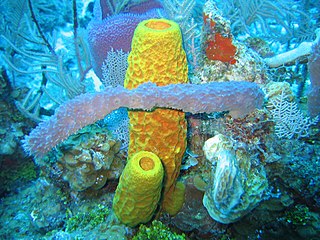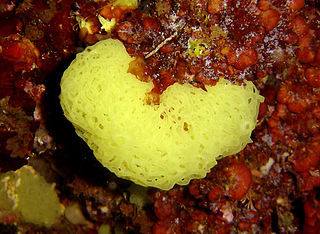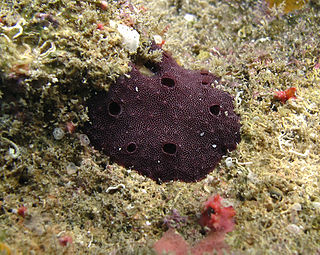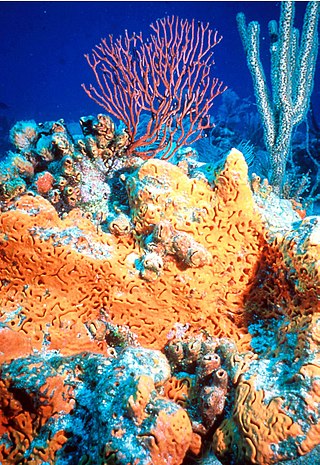
Demosponges (Demospongiae) are the most diverse class in the phylum Porifera. They include greater than 90% of all species of sponges with nearly 8,800 species worldwide. They are sponges with a soft body that covers a hard, often massive skeleton made of calcium carbonate, either aragonite or calcite. They are predominantly leuconoid in structure. Their "skeletons" are made of spicules consisting of fibers of the protein spongin, the mineral silica, or both. Where spicules of silica are present, they have a different shape from those in the otherwise similar glass sponges. Some species, in particular from the Antarctic, obtain the silica for spicule building from the ingestion of siliceous diatoms.

Clathrina is a genus of calcareous sponge in the family Clathrinidae. Several species formerly in Clathrina were transferred to the newly erected genera Arturia, Ernstia, Borojevia, and Brattegardia in 2013. The name is derived from the Latin word "clathratus" meaning "latticed".

Dendroceratida is an order of sponges of the class Demospongiae. They are typically found in shallow coastal and tidal areas of most coasts around the world. They are generally characterized by concentric layers of fibers containing spongin, and by large flagellated chambers that open directly into the exhalant canals. Along with the Dictyoceratida, it is one of the two orders of demosponges that make up the keratose or "horny" sponges, in which a mineral skeleton is minimal or absent and a skeleton of organic spongin-containing fibers is present instead.

Halichondriidae is a family of sea sponges belonging to the order Suberitida. These sponges have a skeleton consisting of dense bundles of spicules occurring in a more or less random pattern.

Homosclerophorida is an order of marine sponges. It is the only order in the monotypic class Homoscleromorpha. The order is composed of two families: Plakinidae and Oscarellidae.
Ascandra izuensis is a species of sea sponge in the family Clathrinidae. The species is named after the Izu peninsula where the holotype was collected.
Pseudospongosorites is a genus of sea sponges belonging to the family Suberitidae. Currently, the genus is considered as monotypic, consisting of a single species Pseudospongosorites suberitoides. It is found in the Caribbean Sea, the Gulf of Mexico and on the Atlantic coast of the United States as far north as North Carolina. This species is known by the common name Florida hermit crab sponge, so named because hermit crabs often use it as shelter.
Homaxinella is a genus of sea sponges in the family Suberitidae. The type species is Homaxinella balfourensis.
Homaxinella balfourensis is a species of sea sponge in the family Suberitidae. It is found in the seas around Antarctica and can grow in two forms, either branching out in one plane like a fan or forming an upright club-like structure.

Agelas is a genus of sea sponge in the class Demospongiae.
Agelas schmidti, commonly known as the brown tubular sponge, is a species of demosponge. It occurs at moderate depths in the Gulf of Mexico and the Caribbean Sea and often has a colonial coral growing over the surface. The type locality is Puerto Rico.
Agelas flabelliformis, also known as the elephant ear sponge, is a species of demosponge. It takes the form of a large leathery slender flap and is found in the Caribbean area at depths down to 100 metres (330 ft).
Dysidea arenaria is a species of marine sponge (poriferan) found in the Pacific Ocean. It is a member of the order Dictyoceratida, one of two sponge orders that make up the keratose or "horny" sponges in which a mineral skeleton is absent and a skeleton of organic fibers is present instead.

Verongimorpha is the name of a subclass of sea sponges within the phylum Porifera. It was first authenticated and described by Erpenbeck et al. in 2012.

Thorectidae is a family of sea sponges in the order Dictyoceratida.

Rossellidae is a family of glass sponges belonging to the order Lyssacinosa. The family has a cosmopolitan distribution and is found at a large range of depths.

Spongillida is an order of freshwater sponges in the subclass Heteroscleromorpha.

Keratosa, the keratose sponges or horny sponges, is a subclass of demosponges.
Gert Wörheide is a German marine biologist who works mainly on marine invertebrates. He earned his doctorate in geobiology from Georg-August-Universität, following this with a post-doctorate at Queensland Museum (1998-2002), where he worked with John Hooper on sponges, a collaboration which continues.










